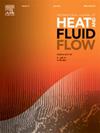Assessing the methods of extracting attached eddies
IF 2.6
3区 工程技术
Q2 ENGINEERING, MECHANICAL
International Journal of Heat and Fluid Flow
Pub Date : 2025-07-22
DOI:10.1016/j.ijheatfluidflow.2025.109983
引用次数: 0
Abstract
The success of the attached eddy model (AEM) and the search for typical representations of attached eddies call for the development of various methods for extracting attached eddies. However, previous studies have not systematically compared these methods in terms of their statistical wall laws for different physical quantities. In particular, the wall laws for arbitrary moments of the velocity gradient and higher-order velocity derivatives in the logarithmic region, derived in our previous study, have not been checked by using these various methods. In the present study, we focus on three methods, that is, the spectral filtering based on streamwise wavelength (SF), proper orthogonal decomposition (POD), and clustering methodology (CM), and assess their ability of capturing the statistical characteristics predicted by the AEM. It is found that based on two-dimensional instantaneous flow fields, the SF method demonstrates the best performance in capturing the statistical laws of velocity gradients and Hessians, followed by CM, while POD proves inadequate for capturing the scaling laws of velocity gradients and Hessians. Moreover, a parametric analysis is carried out to discuss in detail the specific effects of various parameters in each method on the statistical moments. These results are expected to identify key parameters in these methods and contribute to their improvement, enabling better capture of the statistical laws predicted by the AEM.
评价附着物涡流提取方法
附着涡模型(AEM)的成功和寻找附着涡的典型表示要求开发各种提取附着涡的方法。然而,以往的研究并没有系统地比较这些方法在不同物理量下的统计壁律。特别是,在我们之前的研究中得到的速度梯度任意矩和对数区域的高阶速度导数的壁律,并没有通过使用这些不同的方法来检验。本文主要研究了基于顺流波长的光谱滤波(SF)、适当正交分解(POD)和聚类方法(CM)三种方法,并评估了它们捕捉AEM预测的统计特征的能力。结果表明,基于二维瞬时流场,SF方法在捕捉速度梯度和Hessians统计规律方面表现最好,CM方法次之,而POD方法在捕捉速度梯度和Hessians的标度规律方面表现较差。此外,还进行了参数分析,详细讨论了每种方法中各参数对统计矩的具体影响。这些结果有望确定这些方法中的关键参数,并有助于改进这些方法,从而更好地捕捉AEM预测的统计规律。
本文章由计算机程序翻译,如有差异,请以英文原文为准。
求助全文
约1分钟内获得全文
求助全文
来源期刊

International Journal of Heat and Fluid Flow
工程技术-工程:机械
CiteScore
5.00
自引率
7.70%
发文量
131
审稿时长
33 days
期刊介绍:
The International Journal of Heat and Fluid Flow welcomes high-quality original contributions on experimental, computational, and physical aspects of convective heat transfer and fluid dynamics relevant to engineering or the environment, including multiphase and microscale flows.
Papers reporting the application of these disciplines to design and development, with emphasis on new technological fields, are also welcomed. Some of these new fields include microscale electronic and mechanical systems; medical and biological systems; and thermal and flow control in both the internal and external environment.
 求助内容:
求助内容: 应助结果提醒方式:
应助结果提醒方式:


